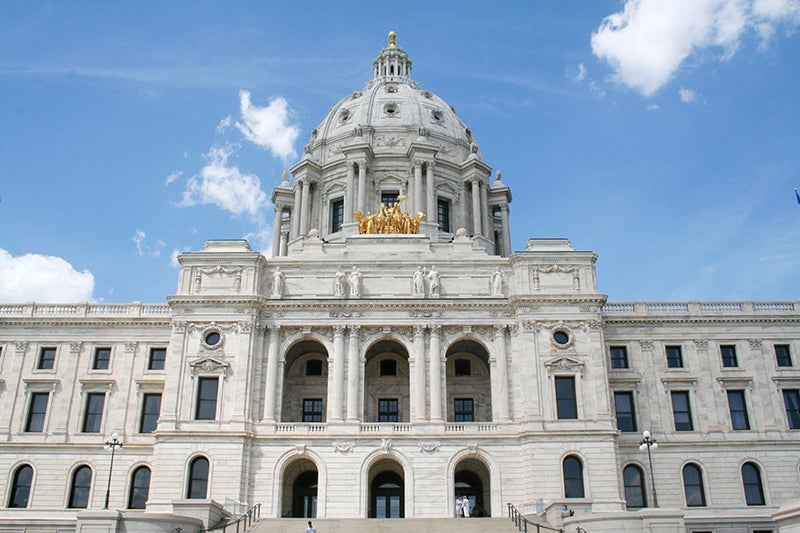Growing power line needs generate new friction in Minnesota’s clean energy shift
Published 6:33 pm Tuesday, August 8, 2023
|
Getting your Trinity Audio player ready...
|
By Kirsti Marohn
Matt Maier spent 15 years building his Thousand Hills farm into a model of environmental stewardship.
On rolling, grassy land west of Becker, he adopted rotational grazing of beef cattle. Among local landowners, he cultivated interest in regenerative farming practices to benefit both the climate and the land.
“I’ve been able to see with my own eyes land come back to life, plants come back to life, pollinators return,” he said recently as he showed a reporter around the farm. “It’s amazing what nature can do in a short amount of time.”
Maier, though, worries his local environmental success story may soon be eclipsed by the needs of a statewide clean energy movement — the push to generate Minnesota’s electricity from carbon-free sources.
Spurred by a new state law and climate goals, utilities in the state are pushing ahead on plans to deliver more solar and wind energy to the electrical grid. That means a massive buildout of hundreds of miles of new power lines across Minnesota — projects that often face pushback from local communities and landowners, especially in rural areas.
Rural Clearwater in Wright County offers a look at both the opportunities and challenges in the state’s clean energy transition. Xcel Energy hopes to deliver wind and solar power to Becker from southwestern Minnesota, which could mean stretching a new high-voltage transmission line across local farm fields, wetlands and creeks.
Maier worries about the trees that would need to be cut to clear a path for the powerline and whether its electromagnetic field would affect his cattle. He also wonders how it might alter his life’s mission of sharing knowledge of holistic agriculture with others.
“We use this as our classroom,” Maier said. “If you’ve got a giant power line running through it, it just kind of defeats what we’re trying to do.”
This region is no stranger to power generation. Just a few miles away, the smokestack of the Sherburne County Generating Plant, or Sherco, rises into the sky. It’s been burning coal to produce electricity since the 1970s.
As concern grows over the climate effects of burning fossil fuels, Xcel plans to retire the coal plant over the next seven years. It’s building a huge solar project in Becker to replace some of that power.
A new Minnesota law requires state utilities to get 100 percent of their electricity from carbon-free sources by 2040. It’s an ambitious mandate expected to drive a major expansion of solar and wind energy across the state.
“The new generation mix is going to be more spread out, so it won’t be these large, central station power plants,” said Beth Soholt, executive director of the nonprofit Clean Grid Alliance, which advocates for renewable energy policy.
To move that solar and wind energy from where it’s produced to where it’s needed — population centers including the Twin Cities metro — will require new power lines, Soholt said.
That includes both high-voltage wires that carry power across Minnesota or multiple states, and smaller ones that distribute electricity at the neighborhood level, she said.
“As we electrify more things, cars, homes, businesses, our distribution system can’t handle all of that,” Soholt said. “So we’re going to need to make investments (in) multiple places.”
Nationally, there’s a growing need for transmission lines to reach clean energy goals. Princeton University researchers estimated power line capacity would need to increase two to five times from 2021 levels to achieve economy-wide net-zero greenhouse gas emissions by 2050.
At the same time, the demand for more electricity is expected to soar as people switch from gasoline-powered to electric vehicles, said Darrick Moe, CEO of the Minnesota Rural Electric Association, which represents the state’s nonprofit electric cooperatives.
“All that’s going to require transmission to move those additional electrons around,” Moe said.
Another key driver of the demand for more power lines is — ironically — climate change. Even as weather patterns are changing, it’s always windy or sunny somewhere, Soholt said.
“We need to be able to capture the energy that’s produced and move it to where it’s needed, at the time it’s needed,” she said. “So we’re transferring larger amounts of power across the power grid, and we need the large transmission lines to be able to do that.”
Clean, affordable power
Plans for some of those projects are already in the works. Last year, the Midcontinent Independent System Operator, which operates the Midwest electric grid, approved $10.3 billion worth of new transmission projects across the Upper Midwest.
The largest in Minnesota is a 180-mile line from the Iron Range to central Minnesota proposed to be built by Minnesota Power and Great River Energy, known as the Northland Reliability Project.
Those projects still need approval by state regulators. In the meantime, MISO is working on plans for more transmission projects in its 15-state region.
Xcel Energy alone expects to build 400 or 500 miles of high-voltage power lines over the next decade, said Michael Lamb, senior vice president of transmission.
That includes the line the Minneapolis-based utility is calling the Minnesota Energy Connection, proposed to run about 140 miles from Lyon County in southwestern Minnesota to Becker.
Using an existing substation at Sherco to connect renewable energy to the electrical grid makes sense and reduces costs, Lamb said.
“The need for this project is simple,” he said. “Connect wind-rich resources to already existing infrastructure, so that we can deliver to our customers what they want — clean, affordable power.”
It’s been nearly a half century since Ronald and Debbie Schabel bought their home near Interstate 94 in Clearwater Township. More than a decade ago, Xcel and other utilities built the CapX2020 transmission line near their house.
Now, they’re facing the prospect of being sandwiched between two major, high-voltage power lines. Ronald Schabel says most of that power goes to the Twin Cities metro, whose residents are unaware of the impact on rural Minnesotans.
“They turn their switch on, and they have no clue of the trauma that it causes the landowners out here in Wright County,” he said.
Schabel worked for Xcel for three decades before retiring, so he understands the need for transmitting electricity. But he doesn’t believe building a bunch of new power lines that crisscross Minnesota makes sense.
“They’re generating a spider web of power lines, high voltage, the nasty ones, throughout from one end of the state to the other,” Schabel said. “How environmentally appealing is that?”
Even supporters of clean energy are urging utilities to use caution when deciding where to build new transmission lines.
Clearwater Township supervisor Rose Thelen is a longtime environmental advocate who urged Xcel to shut down the Sherco coal plant. She supports more solar and wind power, but doesn’t think a new power line should cut through her township.
“We have some very beautiful land in Clearwater Township,” Thelen said. “You don’t know that by going down the freeway. But if you get off the freeway, we’ve got lakes. We’ve got rivers. We’ve got streams. We’ve got untouched forested areas.”
Thelen said she’d prefer to see the power line follow existing corridors, such as a nearby county road.
Lamb said Xcel Energy learned from conflicts over the CapX2020 line, and are reaching out to landowners earlier in the process, adding or eliminating possible routes based on feedback.
But Lamb said utilities including Xcel are also concerned about how long it takes for a transmission line to get needed approval.
“There is a real risk of not being able to achieve our carbon reduction goals because of the long time it takes to conceptualize a project and do all the work,” he said. “It takes seven, eight, nine years to actually get it built.”
Some utilities say there needs to be changes to permitting for new power lines, so regulators still consider their human and environmental impacts, but projects don’t get stalled for years.
“The idea is you should be able to look at all those environmental concerns, but do that in a two-year time window instead of an eight-plus year time window, so that these projects could be moved ahead more effectively than we’ve seen in the recent past,” Moe said.
Soholt said the Minnesota Public Utilities Commission is looking at whether the permitting process can be streamlined by combining certificates of need and route permits, which are currently two separate steps. There are also efforts to increase the voltage on existing power lines rather than building new ones.
“Streamlining the process does not mean forgoing good practices, working with communities and landowners,” Soholt said. “I think we just have to be smart in all aspects of the process.”
Utilities try to negotiate easements to pay landowners for use of their land. They also have the power to take land through government-sanctioned eminent domain. Minnesota’s “Buy the Farm” law requires utilities to buy all or part of property from landowners who don’t agree to an easement.
Matt Langan, an agent who’s working on siting and land rights for the Minnesota Energy Connection project, said Xcel is listening to landowners’ feedback, and is trying to avoid placing power lines too close to homes. It’s also avoiding state or federal lands, and placing towers in the middle of a lake or stream, he said.
“It’s a very lengthy process with lots of things to consider,” Langan said.
Xcel is still considering several possible routes, he said. This fall, it expects to submit at least two alternatives to the Public Utilities Commission, which will hold public hearings before making a decision.
On Thousand Hills farm, Maier’s grass-fed beef business has won accolades for its climate-friendly, holistic farming practices. But he worries about potential changes coming to the hills in the name of clean energy.
Maier said he understands the need to move power, but he wonders whether building huge transmission lines to transport electricity across the state is the most practical solution.
Electricity, he said, should be more decentralized — processed and used closer to where it’s produced, like the food grown on his farm.
“We tend not to think that way,” Maier said. “We think bigger is better and more is better. And as a society, that’s generally what we default to.”





